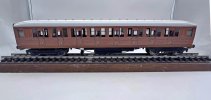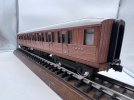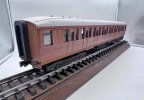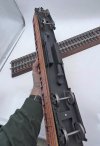You are using an out of date browser. It may not display this or other websites correctly.
You should upgrade or use an alternative browser.
You should upgrade or use an alternative browser.
Gresley Coaches
- Thread starter Fred2179G
- Start date
tac foley
Registered
I picked up a set of Gresley teaks, 1/32nd scale, to go with my live steam B1. (I switched the order for the B1 from BR to LNER in a hurry.)
View attachment 337974
All the teaks are composites, so I have nowhere for a guard to sit. Any thoughts? I wondered if a teak-colored Thompson Brake/3rd might work.
You are pretty mean with the details of this set - any more info forthcoming, or is is a state secret? Anyhow, like most of us, you gots to run with what you gots.
Fred2179G
Registered
Fred2179G
Registered
Bowater seems to make a very nice 6-wheel brake coach that would also be appropriate. There's a pic on their website of a varnished one, I think. And a GNR brake/3rd, which would have gone to the LNER in 1921 in the Grouping.

Bowater calls it a FCWD GNR D.192 Brake Composite Carriage. I think D.192 is the drawing number, but can anyone shed light on "FCWD"?

Bowater calls it a FCWD GNR D.192 Brake Composite Carriage. I think D.192 is the drawing number, but can anyone shed light on "FCWD"?
Last edited:
craigwrdouglas2
Registered
192 is the GNR Diagram number.Bowater seems to make a very nice 6-wheel brake coach that would also be appropriate. There's a pic on their website of a varnished one, I think. And a GNR brake/3rd, which would have gone to the LNER in 1921 in the Grouping.

Bowater calls it a FCWD GNR D.192 Brake Composite Carriage. I think D.192 is the drawing number, but can anyone shed light on "FCWD"?
FCWD is Fareham Carriage Works Designs
(from the description )
This is a wooden kit designed to run on 45mm gauge track. It is based on the Great Northern Railway Brake Composite Carriage to Great Northern Railway Diagram 190. This kit has been designed by Tony Armstrong at Fareham Carriage Works Designs and is exclusively produced by Bowaters Models.
They are described as GNR Howlden 45 Bogie Stock, in Historic Carriage Drawings by Campling. Some parts of diagrams 189, 129 and 277 are reproduced, though probably not in enough depth to model them.
In the configuration pictured It would be one for a short distance train e.g. Suburban, as there doesn't appear to be any toilets on board and no corridor. (The Gresley coaches have both. )
The lavatory composite may be a better bet, but again this does not have corridor connection but one could stretch imagination and fit some.192 is the GNR Diagram number.
FCWD is Fareham Carriage Works Designs
(from the description )
This is a wooden kit designed to run on 45mm gauge track. It is based on the Great Northern Railway Brake Composite Carriage to Great Northern Railway Diagram 190. This kit has been designed by Tony Armstrong at Fareham Carriage Works Designs and is exclusively produced by Bowaters Models.
They are described as GNR Howlden 45 Bogie Stock, in Historic Carriage Drawings by Campling. Some parts of diagrams 189, 129 and 277 are reproduced, though probably not in enough depth to model them.
In the configuration pictured It would be one for a short distance train e.g. Suburban, as there doesn't appear to be any toilets on board and no corridor. (The Gresley coaches have both. )

Great Northern Railway
Welcome to the Bowaters Models webstore! The home of distinctive rolling stock kits for your Garden Railway.
craigwrdouglas2
Registered
The lavatory composite may be a better bet, but again this does not have corridor connection but one could stretch imagination and fit some.

Great Northern Railway
Welcome to the Bowaters Models webstore! The home of distinctive rolling stock kits for your Garden Railway.shop.bowatersmodels.co.uk
I've had a quick re-read of the LNER formations book and the situation with the LNER is that when the LNER was created, it inherited a lot of coaches from the constituent companies. The LNER built the Gresley coaches to upgrade it's coaching stock.
The way that worked was that while high profile services such as the Flying Scotsman was mostly assembled with the new Gresley coaches, the rest of the fleet was updated slowly with set's getting one or 2 new coaches each , rather than full sets of Gresley's being sent out and it wasn't until the 1930s that full rakes of Gresley coaches were commonplace. Restaurant cars were the most expensive to build an d equip, so they were among that last to be replaced in a lot of cases, though there don't seem to ne any in the range.
From the coaches listed on the sites a brake vehicle at each end, either full brake or brake lav. at each end would make sense, though you could add a Pidgeon van or milk van to add interest.
I think the toilets are the important thing - not being able to move around the carriage significantly was fairly typical.
Rhinochugger
Retired Oik
It's fascinating reading some of the railway histories.I've had a quick re-read of the LNER formations book and the situation with the LNER is that when the LNER was created, it inherited a lot of coaches from the constituent companies. The LNER built the Gresley coaches to upgrade it's coaching stock.
The way that worked was that while high profile services such as the Flying Scotsman was mostly assembled with the new Gresley coaches, the rest of the fleet was updated slowly with set's getting one or 2 new coaches each , rather than full sets of Gresley's being sent out and it wasn't until the 1930s that full rakes of Gresley coaches were commonplace. Restaurant cars were the most expensive to build an d equip, so they were among that last to be replaced in a lot of cases, though there don't seem to ne any in the range.
From the coaches listed on the sites a brake vehicle at each end, either full brake or brake lav. at each end would make sense, though you could add a Pidgeon van or milk van to add interest.
I think the toilets are the important thing - not being able to move around the carriage significantly was fairly typical.
Toilet stops were quite a thing until lavatories on trains were introduced. Then, as you say, it was a question of luck as to whether you were in one of the compartments with access to the khasi.
Meal stops were also a requirement. Some of the main UK stations had massive restaurants where a train-load of passengers were expected to be fed and watered in about ten minutes!
Hence the old saying about pouring British Railways tea - a large pot, a row of cups, and you just keep pouring along the row in one continuous movement




